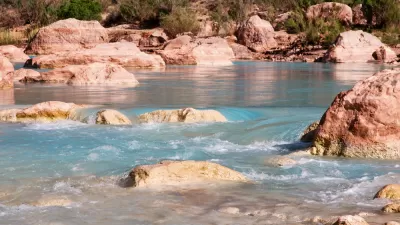Cities across America have been revitalizing their waterfronts for decades with new parks and development replacing heavy industry. But, a new breed of advocates is going one step further, and pushing for a time when people can just jump right in.
Will Doig profiles the "early adopters of the idea that cities' rivers and canals, cleaner than they've been in a century, are ripe for recreational use." Active in cities like Los Angeles and New York, where coming into contact with the city's "natural" aquatic resources would have demanded a trip to the doctor just a couple of decades ago, these pioneers are leading the charge in redefining how their city's waterways are viewed and used.
According to Doig, "public pressure, combined with new technological cleanup advances,
is changing some cities' waterways so quickly that they may soon be
unrecognizable. In fact, this transitional moment might be the most
intriguing time to explore such areas, especially for anyone who loves
the hidden and ignored corners of cities where few dare to venture -
those weedy, quiet, eerily beautiful abandoned spots that, just a few
years from now, might be jam-packed with backstrokers and jet skiers."
"Indeed," says Doing, "there's something about the potential opening up of these urban
waterways that sparks fevered interest. Maybe it's because, in suddenly
gentrifying cities, where forsaken space is quickly disappearing, they
represent a last wild frontier."
FULL STORY: Let’s swim to work!

Planetizen Federal Action Tracker
A weekly monitor of how Trump’s orders and actions are impacting planners and planning in America.

Map: Where Senate Republicans Want to Sell Your Public Lands
For public land advocates, the Senate Republicans’ proposal to sell millions of acres of public land in the West is “the biggest fight of their careers.”

Restaurant Patios Were a Pandemic Win — Why Were They so Hard to Keep?
Social distancing requirements and changes in travel patterns prompted cities to pilot new uses for street and sidewalk space. Then it got complicated.

Platform Pilsner: Vancouver Transit Agency Releases... a Beer?
TransLink will receive a portion of every sale of the four-pack.

Toronto Weighs Cheaper Transit, Parking Hikes for Major Events
Special event rates would take effect during large festivals, sports games and concerts to ‘discourage driving, manage congestion and free up space for transit.”

Berlin to Consider Car-Free Zone Larger Than Manhattan
The area bound by the 22-mile Ringbahn would still allow 12 uses of a private automobile per year per person, and several other exemptions.
Urban Design for Planners 1: Software Tools
This six-course series explores essential urban design concepts using open source software and equips planners with the tools they need to participate fully in the urban design process.
Planning for Universal Design
Learn the tools for implementing Universal Design in planning regulations.
Heyer Gruel & Associates PA
JM Goldson LLC
Custer County Colorado
City of Camden Redevelopment Agency
City of Astoria
Transportation Research & Education Center (TREC) at Portland State University
Camden Redevelopment Agency
City of Claremont
Municipality of Princeton (NJ)





























